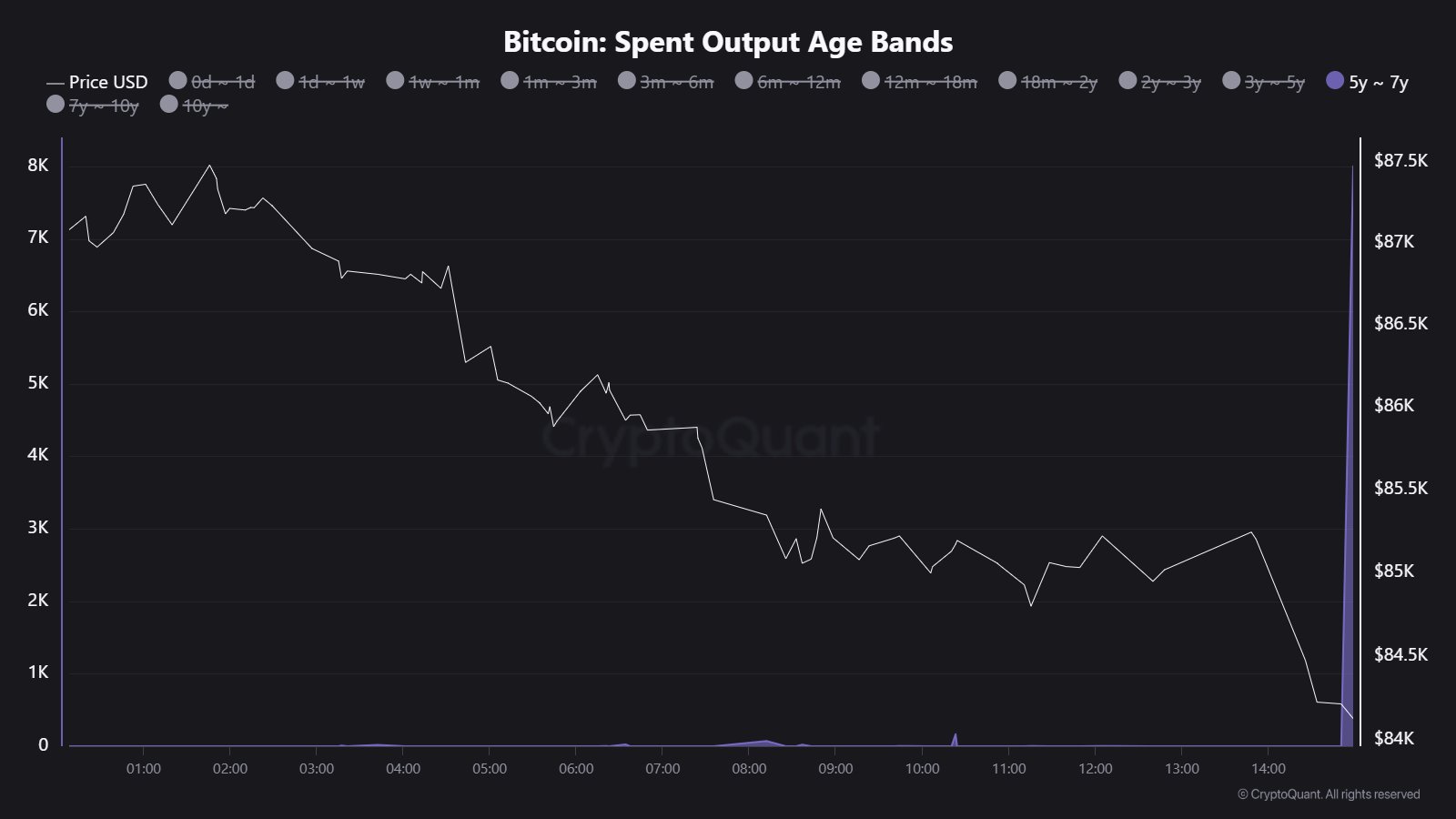Bitcoin
Bitcoin at $13 Million? Saylor Predicts, Schiff Calls Nonsense


In a CNBC interview, Michael Saylor predicted a Bitcoin Price of $13 million. However, Peter Schiff called this “a bunch of nonsense.” Schiff trashed Bitcoin and espoused gold in a separate interview.
With gold’s price on the rise and Bitcoin’s falling, Schiff defended what he called the “apex money”.
Saylor Predicts a $13 Million Bitcoin
Michael Saylor made an interview appearance on NBC’s “Squawk Box” on September 9, pushing his bullish views on Bitcoin.
Although Bitcoin’s price has risen over the day, Saylor made this initial appearance in the context of decreasing trendlines overall. Host Joe Squawk told Saylor that “you have a lot of courage, because there’s been a lot of major swings in the past”. When asked if he had any major “close calls”, however, Saylor was resolute.
Saylor discussed the lowest point in his Bitcoin journey when Silvergate Bank failed. It seemed like a close call for MicroStrategy, but “it turned out to be a benefit for us. We made a lot of money.”
He described the recent market in similar terms, saying that MicroStrategy’s growth “beat every single company in the S&P index.” And all that despite Bitcoin’s price wobbles. Since adopting their Bitcoin strategy, Saylor claimed that MicroStrategy has largely transformed into a Bitcoin development company.
From this background, he described Bitcoin’s greatest strengths, especially its fluid and easily leveraged maneuvers. Saylor ended with a bold prediction of Bitcoin rising to $13 million in 21 years, in the vein of other strongly pro-Bitcoin statements he’s made.
Schiff: A Bunch of Nonsense
Stockbroker and financial commentator Peter Schiff went on the offense, however. Schiff lambasted Saylor’s comments as “a bunch of nonsense.” Specifically, he noted that Saylor found a friendly and receptive audience from Squawk Box because “CNBC is too beholden to their crypto advertisers to really push back against your false statements.”
He went on to state that MicroStrategy’s valuation is “down 40% from its 52-week high” and that “returns are not nearly as rosy as you describe and will soon get worse.” Schiff added that “all funds have positive returns since inception,” skewing Saylor’s long-term claims.
Schiff’s complaints of an overly friendly interviewer are more genuine than they first appear. That same morning, Schiff argued for gold’s superiority over Bitcoin. Schiff only mentioned Saylor in passing, forming a wholly unrelated argument against Bitcoin.
Still, Schiff found a much less receptive audience to his claim that Bitcoin lacks gold’s “most important aspect…the underlying value of the commodity itself.”
Hosts Ryan Sean Adams and David Hoffman were skeptical of Schiff’s claim that gold has inherent value. “It’s a consensus,” claimed Adams. People have to want to store their value in gold.”
When Adams asked his peers, he claimed that “bulky” gold jewelry lost its appeal among younger people. While gold may have practical use in modern industrial settings, that’s not enough to keep its appeal relevant. Use cases for iPhone computer chips are all well and good, after all, but nobody’s claiming that we should all adopt the palladium standard.
Schiff’s pro-gold stances were bolstered by gold’s performance next to Bitcoin, as gold climbed steadily while Bitcoin saw downturns. Still, Schiff’s hostility to Saylor’s appearance does not equate to a complete hostility to Bitcoin. Although he was generally opposed to crypto in his own interview, Schiff was able to make a hypothetical case for it when pressed.
Read more: Bitcoin (BTC) Price Prediction 2024/2025/2030
“It’s possible that people might take refuge in Bitcoin,” he claimed. Schiff ultimately urged his audience to “hedge your bets”, investing in both commodities, so that “even if Saylor is right, you’ll still be rich.”
Disclaimer
In adherence to the Trust Project guidelines, BeInCrypto is committed to unbiased, transparent reporting. This news article aims to provide accurate, timely information. However, readers are advised to verify facts independently and consult with a professional before making any decisions based on this content. Please note that our Terms and Conditions, Privacy Policy, and Disclaimers have been updated.
Bitcoin
Gold Keeps Outperforming Bitcoin Amid Trump’s Trade War Chaos
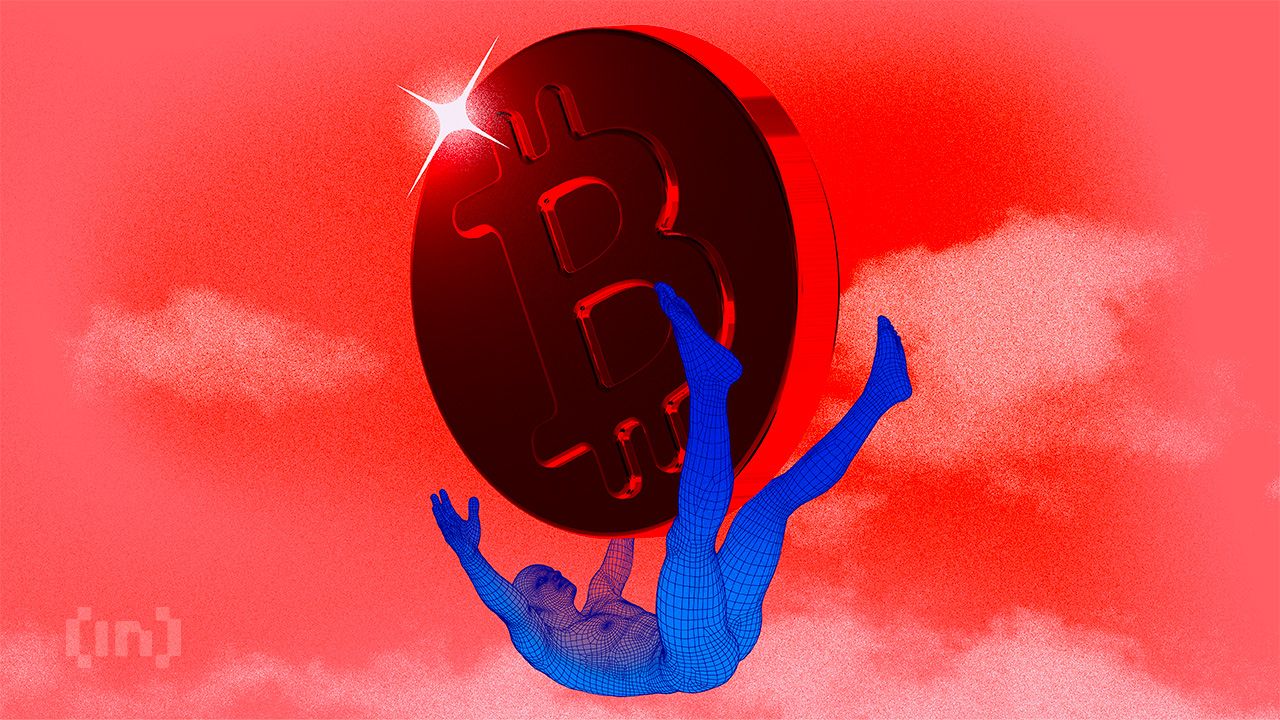
Bitcoin (BTC) has long been touted as “digital gold.” However, as the global economy reels from escalating trade war tensions under Trump’s second term, institutional investors are fleeing to the real thing.
A recent Bank of America (BofA) survey found that 58% of fund managers view gold as the best-performing haven in a trade war—leaving Bitcoin with only a 3% preference.
Bitcoin’s Haven Status Faces a Reality Check
Gold is proving its dominance as the crisis asset of choice while Bitcoin struggles to hold its ground. This comes amid rising geopolitical risks, the ballooning US deficit, and uncertainty driving capital flight.
“In a recent Bank of America survey, 58% of fund managers said gold performs best in a trade war. This compares to just 9% for 30-year Treasury Bonds and 3% for Bitcoin,” The Kobeissi Letter noted.
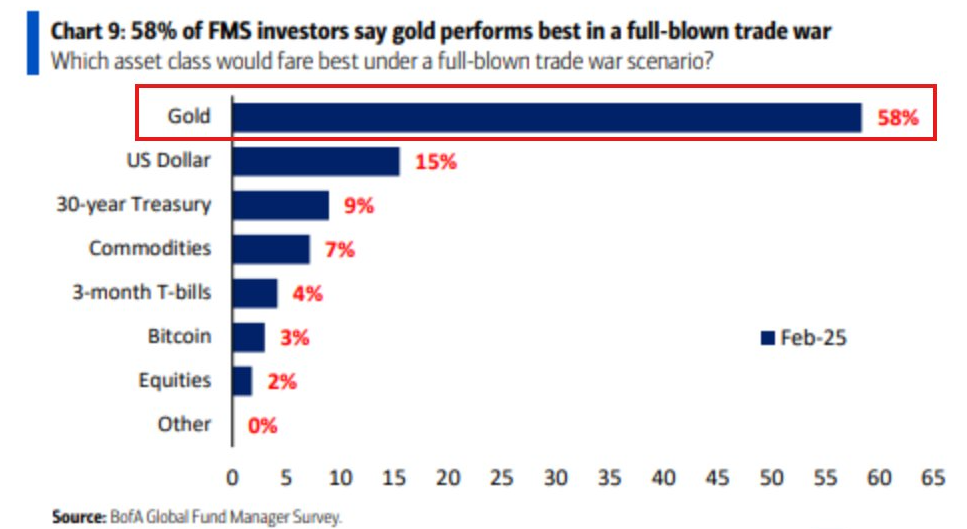
For years, Bitcoin advocates have championed it as a hedge against economic instability. Yet, in 2025’s volatile macro environment, Bitcoin struggles to earn institutional investors’ full trust.
The Bank of America survey reflects this status, with long-term US Treasury bonds and even the US dollar losing appeal as trade wars and fiscal dysfunction shake market confidence.
The US deficit crisis—now projected to exceed $1.8 trillion—has further eroded confidence in traditional safe havens like US Treasuries.
“This is what happens when the global reserve currency no longer behaves as the global reserve currency,” a trader quipped in a post.
However, instead of looking to Bitcoin as an alternative, institutions are overwhelmingly choosing gold, doubling physical gold purchases to record levels.
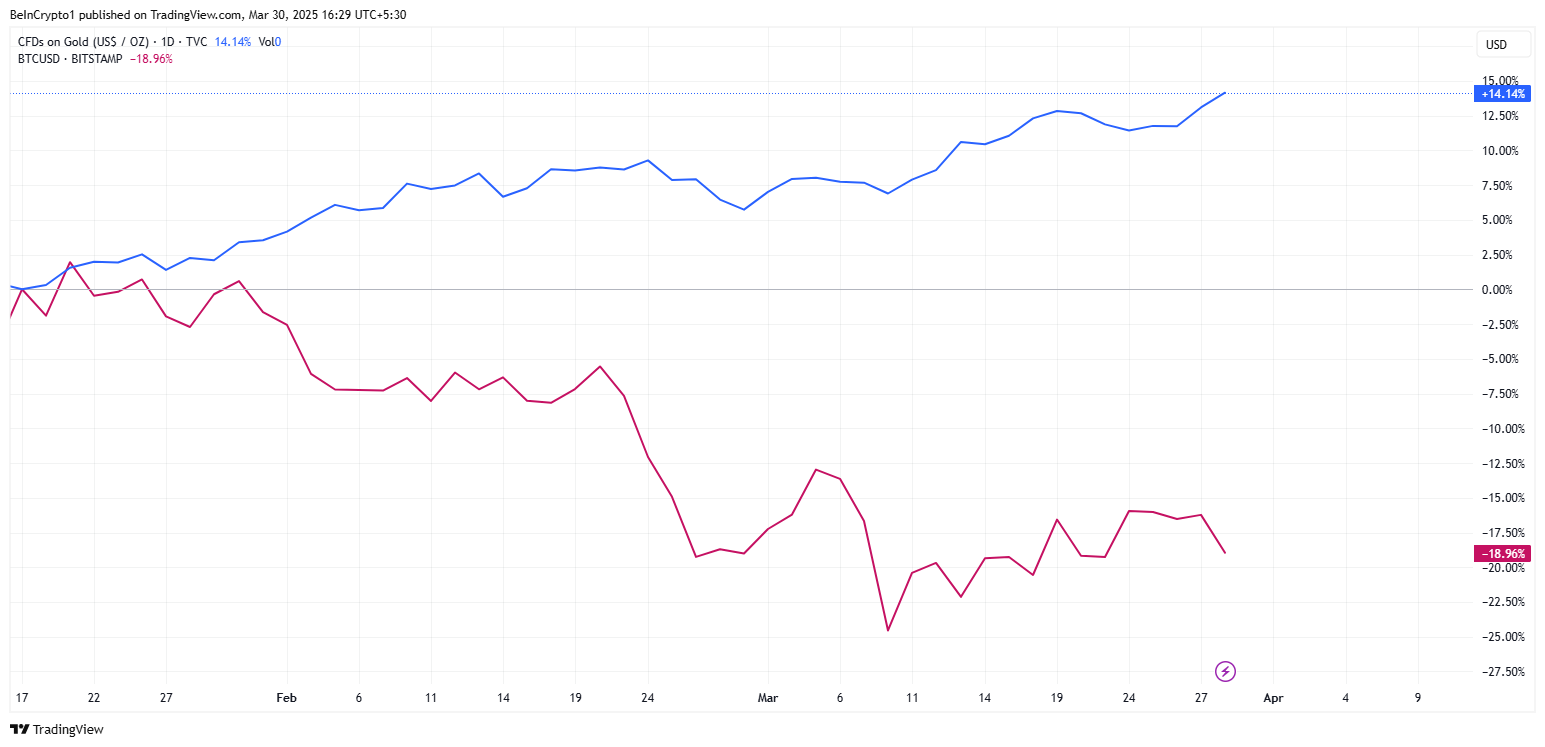
Barriers To Bitcoin Institutional Adoption
Despite its fixed supply and decentralization, Bitcoin’s short-term volatility remains a key barrier to institutional adoption as a true safe-haven asset.
While some traders still view Bitcoin as a long-term store of value, it lacks the immediate liquidity and risk-averse appeal that gold provides during crises.
Further, President Trump is expected to announce sweeping new tariffs on “Liberation Day.” Experts flag the event as a potential trigger for extreme market volatility.
“April 2nd is similar to election night. It is the biggest event of the year by an order of magnitude. 10x more important than any FOMC, which is a lot. And anything can happen, “Alex Krüger predicted.
Trade tensions have historically driven capital into safe-haven assets. With this announcement looming, investors preemptively position themselves again, favoring gold over Bitcoin.
“Gold’s no longer just a hedge against inflation; it’s being treated as the hedge against everything: geopolitical risk, de-globalization, fiscal dysfunction, and now, weaponized trade. When 58% of fund managers say gold is the top performer in a trade war, that’s not just sentiment that’s allocation flow. When even long bonds and the dollar take a back seat, it’s a signal: the old playbook is being rewritten. In a world of rising tariffs, FX tension, and twin deficits, gold might be the only politically neutral store of value left,” trader Billy AU observed.
Despite Bitcoin’s struggle to capture institutional safe-haven flows in 2025, its long-term narrative remains intact.
Specifically, the global reserve currency system is changing, US debt concerns are mounting, and monetary policies continue to shift. Despite all these, Bitcoin’s value proposition as a censorship-resistant, borderless asset is still relevant.
However, in the short term, its volatility and lack of widespread institutional adoption as a crisis hedge mean gold is taking the lead.
For Bitcoin believers, the key question is not whether Bitcoin will one day challenge gold but how long institutions will adopt it as a flight-to-safety asset.
Until then, gold remains the undisputed king in times of economic turmoil. Meanwhile, Bitcoin (BTC exchange-traded funds notwithstanding) fights to prove its place in the next financial paradigm shift.
“The ETF demand was real, but some of it was purely for arbitrage…There was a genuine demand for owning BTC, just not as much as we were led to believe,” analyst Kyle Chassé said recently.
Disclaimer
In adherence to the Trust Project guidelines, BeInCrypto is committed to unbiased, transparent reporting. This news article aims to provide accurate, timely information. However, readers are advised to verify facts independently and consult with a professional before making any decisions based on this content. Please note that our Terms and Conditions, Privacy Policy, and Disclaimers have been updated.
Bitcoin
Why Bitcoin Seasoned Investors Are Accumulating — Analyst Evaluates BTC’s Current Phase


The cryptocurrency market has not had a clear direction in 2025, reflecting the uncertain condition of the digital asset industry. Bitcoin, the world’s largest cryptocurrency by market capitalization, is currently 24% away from its record-high price of $108,786 reached in January 2025.
With the premier cryptocurrency steadily drifting away from its all-time high, there have been questions about what phase of the cycle the market is currently in. Interestingly, recent on-chain data offers some insight into the current state of the Bitcoin market and the reaction of the participants.
Are Seasoned BTC Investors Anticipating A Price Surge?
In a Quicktake post on the CryptoQuant platform, analyst Axel Adler Jr. shared an analysis of the current Bitcoin cycle, offering insight into the behavior of an important group of investors. According to the online pundit, seasoned BTC players are back to accumulating the flagship cryptocurrency.
Adler Jr. revealed that the experienced BTC investors have been involved in four phases of accumulation (January 2023, October 2023, October 2024, March 2025) in the current cycle. On the flip side, the selling activity of these market participants has reached four distinct peaks, including January 2024, April 2024, July 2024, and January 2025.
The relevant on-chain indicator here is the Value Days Destroyed (VDD) metric, which tracks the spending behaviour of long-term investors. The chart below shows that the VDD metric has been steadily declining since the start of 2025.

Source: CryptoQuant
Using the chart as a basis, Adler Jr. mentioned that three major features define the current phase of the Bitcoin cycle. Firstly, the seasoned investors, who were actively distributing their BTC at local peaks, have now shifted their strategy toward holding and accumulating their coins.
Additionally, the Value Days Destroyed metric suggests an absence of significant selling pressure, which means that the experienced traders are skeptical about profit at the current Bitcoin price. Moreover, periods of low VDD values have historically preceded significant upward price movements, as investors accumulate in anticipation of a price surge.
Ultimately, this positive shift in the behavior of seasoned Bitcoin holders suggests that there might be room for further price growth for Bitcoin in the medium term.
Bitcoin Price At A Glance
As of this writing, the price of BTC sits at around $83,200, with an over 2% decline in the past 24 hours. According to data from CoinGecko, the flagship cryptocurrency is also down by about 2% on the weekly timeframe.
BTC price reclaims $83,000 level on the daily timeframe | Source: BTCUSDT chart on TradingView
Featured image created by DALL-E, chart from TradingView

Editorial Process for bitcoinist is centered on delivering thoroughly researched, accurate, and unbiased content. We uphold strict sourcing standards, and each page undergoes diligent review by our team of top technology experts and seasoned editors. This process ensures the integrity, relevance, and value of our content for our readers.
Bitcoin
8,000 Dormant Bitcoin Suddenly Move: What’s Next For The Market?

Popular CryptoQuant analyst Maartunn reports that 8,000 Bitcoin (BTC) which have been dormant for five to seven years have been moved suddenly, adding to current bearish concerns in the crypto. This development comes after a rather adventurous week as BTC prices struggled to break above $89,000, following an initial steady bullish climb, before succumbing to heavy selling pressures driven by US President Donald Trump’s hawkish tariff policy.
$674 Million In Old BTC Transfers In Single Block – Cause For Alarm?
The Spent Output Age Bands is a crucial metric to measure how long Bitcoin tokens remain inactive before moving. According to Maartuun in an X post, this metric has recently revealed that 8,000 BTC worth $674 million that was last transferred between 2018 and 2020 have been moved recently in a single block drawing significant market attention.
This transfer follows a string of recent activations of dormant Bitcoin stashes. On March 24, a 14-year inactive Bitcoin wallet suddenly moved 100 Bitcoin valued at $8.5 million. Meanwhile, in early March, six ancient Bitcoin wallets also transferred nearly 250 BTC worth $22 million.
Notably, the most recent transaction reported by Maartuun is of far larger size with potentially strong implications for an uncertain Bitcoin market. Generally, a movement of such a large amount of BTC from long-term dormancy is usually interpreted as a signal for incoming selling pressure leading to major price corrections.
However, there are other potential non-bearish motives behind such transactions such as internal wallet shuffling by institutional investors or large holders as well as a cold storage reorganization. Currently, the owners of the new wallets receiving the 8000 is unknown thus reducing the potential of a bearish reaction from BTC holders.
Bitcoin Price Overview
In the last day, Bitcoin prices declined by 4.00% after the US Government announced intentions to impose a 25% tariff on auto imports and goods from China, Mexico, and Canada starting from April 3. This marks the latest negative reaction of the crypto market to President Trump’s international trade policies following similar incidents in early February and mid-March.
These measures by the Donald Trump administration are flaming fears of a potential economic slowdown which could further push high-risk assets such as BTC out of investors’ portfolios leading to a further downside.
At press time, Bitcoin currently trades at $83,693 reflecting a decline of 0.72% and 2.53% in the last seven and 30 days respectively. Meanwhile, the asset’s daily trading volume is up by 19.38% and is valued at $31.58 billion. The BTC market cap now stands at $1.66 trillion and still represents a dominant 61.1% of the total crypto market.
BTC trading at $83,727 on the daily chart | Source: BTCUSDT chart on Tradingview.com
-

 Ethereum16 hours ago
Ethereum16 hours agoWhales Accumulate 470,000 Ethereum In One Week – Bullish Momentum Ahead?
-

 Market19 hours ago
Market19 hours agoWhale Leverages $27.5 Million PEPE Long on Hyperliquid
-

 Ethereum18 hours ago
Ethereum18 hours agoEthereum May Have Hit Cycle Bottom, But Pricing Bands Signal Strong Resistance At $2,300
-

 Ethereum17 hours ago
Ethereum17 hours agoEthereum Analyst Eyes $1,200-$1,300 Level As Potential Acquisition Zone – Details
-
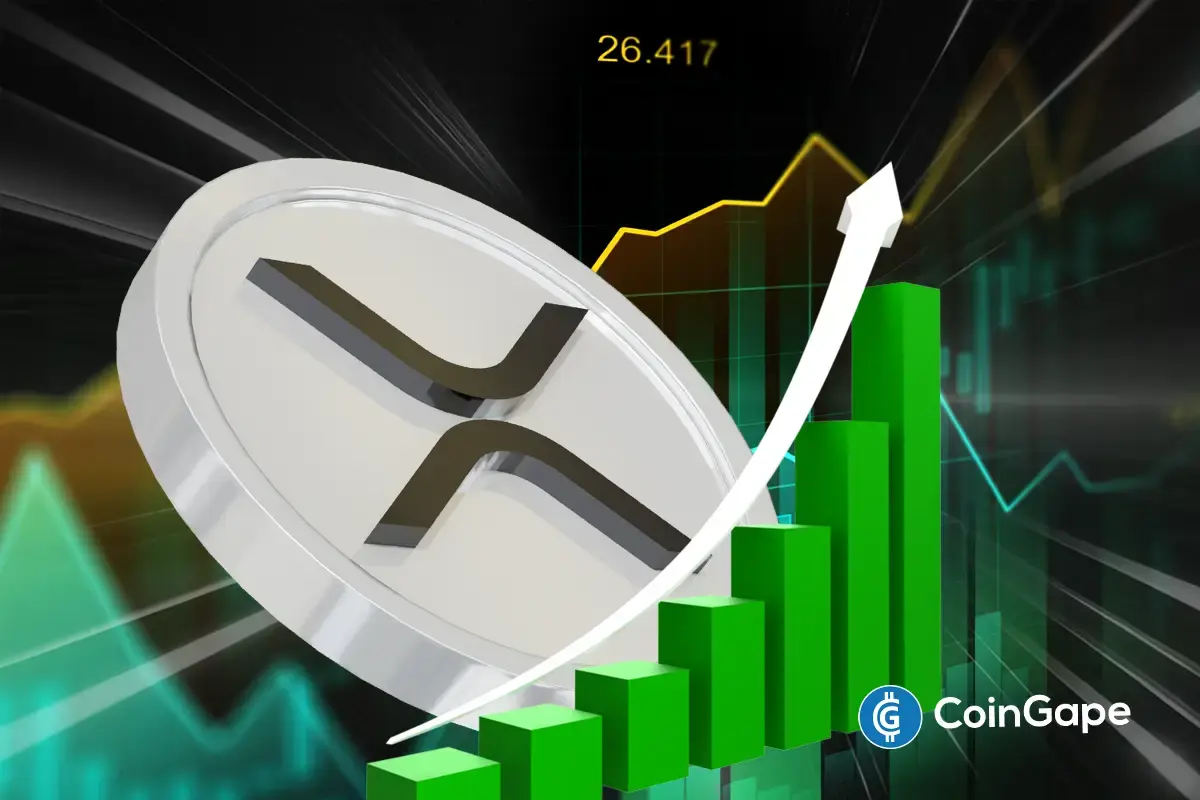
 Altcoin16 hours ago
Altcoin16 hours agoAnalyst Reveals Why The XRP Price Can Hit ATH In The Next 90 To 120 Days
-

 Bitcoin23 hours ago
Bitcoin23 hours agoWhy Bitcoin Seasoned Investors Are Accumulating — Analyst Evaluates BTC’s Current Phase
-

 Market22 hours ago
Market22 hours agoCrypto Derivatives Get a Boost from US CFTC
-

 Market15 hours ago
Market15 hours ago3 Token Unlocks for April: Parcl, deBridge, Scroll










